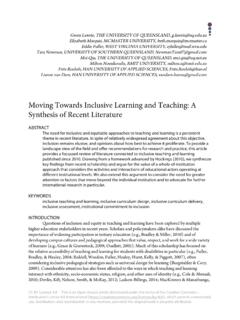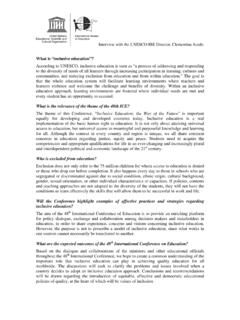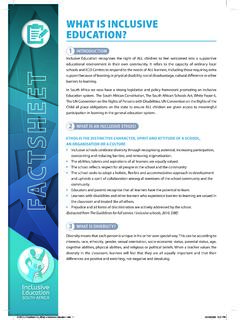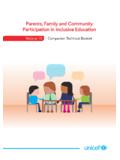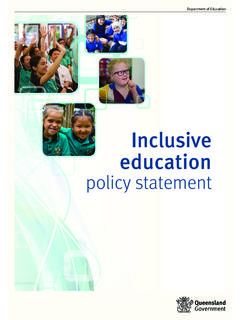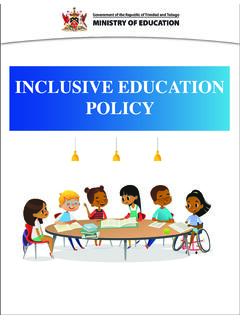Transcription of INCLUSIVE HEALTH SERVICES FOR PERSONS WITH …
1 INCLUSIVE HEALTH SERVICESFOR PERSONS WITH DISABILITIESINCLUSIVE HEALTH SERVICES FOR PERSONS WITH DISABILITIEST oolkit on disability for AFRICAM odule 10 - INCLUSIVE HEALTH SERVICES FOR PERSONS WITH DISABILITIESiiiTOOLKIT ON DISABILITY FOR AFRICATABLE OF CONTENTS1. OVERVIEW ..12. TECHNICAL CONTENT .. Background .. Legal Framework .. Access to HEALTH for PERSONS with Disabilities: Areas of Concern ..7 Country Checkpoint .. Measures to Ensure the Right of PERSONS with Disabilities to HEALTH SERVICES ..12 Country Checkpoint ..183. SUMMARY & KEY LEARNING POINTS ..194. USEFUL RESOURCES ..205. LEARNING ACTIVITIES ..21 Session Sheet for the Trainer The Right to HEALTH , Session 1 ..22 Learning Activity : The Inter-Connected Relation of Rights ..23 Handout: CRPD Article 25 ..24 Session Sheet for the Trainer The Right to HEALTH , Session 2 ..25 Learning Activity A Plan to Address Barriers to HEALTH Care ..26 Handout: Barriers to HEALTH Care for PERSONS with Disabilities.
2 27 Module 10 - INCLUSIVE HEALTH SERVICES FOR PERSONS WITH DISABILITIESivTOOLKIT ON DISABILITY FOR AFRICAA cknowledgements The Division for Social Policy and Development (DSPD) would like to thank all those who contributed to the Toolkit on Disability for Africa, including the United Nations Office for the High Commissioner for Human Rights (OHCHR), the Economic Commission for Africa (ECA), the International Labour Office (ILO), the International Training Center - ILO (ITC-ILO), the World HEALTH Organisation (WHO), the African Union and the governments of Kenya, South Africa and Zambia. DSPD also wishes to thank the Government of Italy for its financial support and the numerous African Disabled Peoples Organisations (DPOs) who contributed substantial input to the 10 - INCLUSIVE HEALTH SERVICES FOR PERSONS WITH DISABILITIESvTOOLKIT ON DISABILITY FOR AFRICAList of acronymsAT Assistive TechnologyCEDAW Committee on the Elimination of Discrimination against WomenCEDAW Convention on the Elimination of All Forms of Discrimination against WomenCESCR Committee on Economic.
3 Social and Cultural RightsCRPD Convention on the Rights of PERSONS with DisabilitiesCRPD Committee on the Rights of PERSONS with DisabilitiesCRC Committee on the Rights of the ChildCRC Convention on the Rights of the ChildCRC Convention on the Rights of the ChildDFIs Development Financing InstitutionsDPOs Disabled PERSONS Organizations DSPD Division for Social Policy and Development/UNDESAEC European CommissionG3 ICT Global Initiative for INCLUSIVE ICTsHIV/AIDS Human Immunodeficiency virus / Acquired Immunodeficiency SyndromeICCPR International Covenant on Civil and Political RightsICESCR International Covenant on Economic and Cultural RightsICF International Classification of Function, The World HEALTH OrganizationICT Information and Communication TechnologyILO International Labour OrganizationITCILO International Training Centre of the ILOIPU Inter-Parliamentary UnionITC Information and Communication TechnologyITU International Telecommunication Union MDGs Millennium Development GoalsMFIs Microfinance institutionsMSPs Multi-stakeholder Partnerships NAPs National Action PlansNGO Non-Governmental OrganizationNVDA Non Visual Desktop Access OHCHR Office of the High Commissioner for Human RightsOSISA Open Society Initiative for Southern AfricaModule 10 - INCLUSIVE HEALTH SERVICES FOR PERSONS WITH DISABILITIESviTOOLKIT ON DISABILITY FOR AFRICAPCM Project Cycle ManagementPRP Protracted Relief ProgrammeSABE Self-Advocates Becoming EmpoweredSDGs Sustainable Development Goals UDHR Universal Declaration of Human RightsUN United NationsUN DESA United Nations Department of Economic and Social AffairsUNAIDS Joint United Nations
4 Programme on HIV/AIDSUNDP United Nations Development FundUNESCO United Nations Educational, Scientific and Cultural OrganizationUNICEF United Nations Children's FundUSAID United States Agency for International DevelopmentVOCA Voice Output Communication AidsWHO World HEALTH OrganizationModule 10 - INCLUSIVE HEALTH SERVICES FOR PERSONS WITH DISABILITIES1 TOOLKIT ON DISABILITY FOR AFRICA1. OVERVIEWThe overview provides information on the objectives, the target audience, the module content, learning outcomes and the module objectives To highlight the barriers to HEALTH SERVICES for PERSONS with disabilities and to consider actions for removing is this module for?This module is relevant to everyone who has an interest or duty to protect and promote the human rights of PERSONS with disabilities. The module is especially relevant for decision-makers in the context of HEALTH , HEALTH professionals, HEALTH care providers, and DPOs working on enhancing the access of PERSONS with disabilities to HEALTH is this module about?
5 The content of this module: explains the linkages between HEALTH and disability generally; reviews provisions of the Convention on the Rights of PERSONS with Disabilities (CRPD) pertaining to HEALTH SERVICES ; reviews specific areas of concern in relation to access to HEALTH SERVICES ; sets out measures for overcoming barriers to the inclusion of PERSONS with disabilities in HEALTH SERVICES ; includes learning exercises to accompany the material; lists key resources for additional reference. 10 - INCLUSIVE HEALTH SERVICES FOR PERSONS WITH DISABILITIES2 TOOLKIT ON DISABILITY FOR AFRICAL earning objectivesOn completion of this module, participants will have:1. reviewed the main provisions of CRPD pertaining to HEALTH SERVICES ; 2. identifi ed specifi c areas of concern in relation to access to HEALTH SERVICES ;3. devised a number of strategies for overcoming barriers to the inclusion of PERSONS with disabilities in HEALTH map1. OVERVIEW2. TECHNICAL Legal Access to HEALTH for PERSONS with Disabilities: Areas of Concern Measures to Ensure the Rights of PERSONS with Disabilities to HEALTH Services3.
6 SUMMARY & KEY LEARNING POINTS4. USEFUL RESOURCES5. LEARNING ACTIVITIESM odule 10 - INCLUSIVE HEALTH SERVICES FOR PERSONS WITH DISABILITIES3 TOOLKIT ON DISABILITY FOR AFRICA2. TECHNICAL BackgroundThe World HEALTH Organization defines HEALTH as a complete state of physical, mental and social well-being, and not merely the absence of disease or infirmity. 1 It has been said that, while HEALTH is not everything, everything is nothing without HEALTH . This is because good HEALTH is a prerequisite for the enjoyment of and participation in many fundamental aspects of life, including education , work and society. HEALTH is determined by a broad range of factors, most of which are outside the HEALTH sector. Social, economic and environmental factors are the main external determinants of HEALTH . PERSONS with disabilities who experience disproportionately high rates of poverty often face conditions that impact negatively on their HEALTH , including lack access to education , sanitary living conditions, clean water and food security, among others.
7 At an individual level, factors such as age, sex, hereditary factors and lifestyle choices are important. The number of PERSONS living with disabilities is growing as a result of factors such as population increase, ageing, and medical advances that preserve and prolong life. This has increased the demand for HEALTH SERVICES . Some PERSONS with disabilities are more susceptible than the general population to secondary HEALTH conditions. As a result, PERSONS with disabilities may have greater needs than the general population. HEALTH promotion SERVICES for the prevention of further disability and the promotion of HEALTH in general are important in determining the quality of life and HEALTH status of those with with disabilities experience significant barriers to accessing HEALTH care. Barriers which can be particularly severe for those residing in rural areas, can include the following: physically inaccessible medical clinics and hospitals; lack of appropriate transport to enable them to seek medical care or rehabilitation SERVICES ; lack of communications and accommodation in HEALTH care settings; untrained personnel and inadequate staffing; negative attitudes of HEALTH care providers; harmful practices, particularly in relation to PERSONS with psychosocial disabilities; denial of treatment on grounds of with all members of the general population, the HEALTH needs of PERSONS with disabilities can vary broadly.
8 The range of SERVICES available to the general population must also be accessible to PERSONS with all types of disability. Care must also be taken to meet the HEALTH needs of those with invisible disabilities, particularly those with psychosocial disabilities and other mental HEALTH conditions. Ensuring optimal mental HEALTH is an integral part of HEALTH service provision, but has received inadequate attention by policy makers and also by society in general. As a result it imposes an enormous disease burden and an increasing obstacle to development in countries around the governments cannot offer guarantees against illness or disease, they are responsible for undertaking measures to advance human HEALTH , whether in the social, physical, legal or economic Constitution of the World HEALTH Organization. Geneva, World HEALTH Organization, 1948 Module 10 - INCLUSIVE HEALTH SERVICES FOR PERSONS WITH DISABILITIES4 TOOLKIT ON DISABILITY FOR AFRICAThe Medical Model vs.
9 The Social Model of DisabilityThe Medical Model of Disability:Perhaps the most significant and widespread myth affecting human rights and disability is the idea that disability is simply a medical problem that needs to be solved or an illness that needs to be cured. This notion implies that a person with a disability is somehow broken or sick and requires fixing or healing. By defining disability as the problem and medical intervention as the solution, individuals, societies, and governments avoid the responsibility for addressing the barriers that exist in the social and physical environment. Instead they place the burden of addressing the problem in the person with the disability on the HEALTH profession. Many governments throughout the world have fuelled the medical model by funding extensive medical research that aims to find the cure for certain disabilities, while not providing any funding to remove the barriers that create disability in Social Model of DisabilityThe social model envisions disability as something that is created by the barriers and attitudes in society, not a trait or characteristic that is inherent in the person.
10 Under the social model, society creates many of the social and physical barriers we consider disabling, and this model focuses on eliminating those barriers, not on fixing or curing disabilities. This includes modifying the created environment, providing information in accessible formats and ensuring that laws and policies support the exercise of full participation and from Janet Lord and Allison deFranco, Human Rights Yes! The Convention on the Rights of PERSONS with Disabilities, The Right to HEALTH , available at: Legal FrameworkThe right to HEALTH is well established in international human rights law, including in the International Covenant on Economic, Social and Cultural Rights,2 which recognizes the right of all PERSONS to the highest attainable standard of HEALTH (Art. 12); and the Convention on the Rights of the Child, which requires State parties to recognize the rights of children with disabilities to specific assistance to ensure their effective access to HEALTH care SERVICES and rehabilitation SERVICES in a manner conducive to the child's achieving the fullest possible social integration and individual development, including his or her cultural and spiritual development (Art.)










